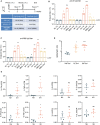Immunogenicity of a vaccinia virus-based severe acute respiratory syndrome coronavirus 2 vaccine candidate
- PMID: 35935962
- PMCID: PMC9353262
- DOI: 10.3389/fimmu.2022.911164
Immunogenicity of a vaccinia virus-based severe acute respiratory syndrome coronavirus 2 vaccine candidate
Abstract
Severe acute respiratory syndrome coronavirus 2 (SARS-CoV-2) vaccines provide essential tools for the control of the COVID-19 pandemic. A number of technologies have been employed to develop SARS-CoV-2 vaccines, including the inactivated SARS-CoV-2 particles, mRNA to express viral spike protein, recombinant spike proteins, and viral vectors. Here, we report the use of the vaccinia virus Tiantan strain as a vector to express the SARS-CoV-2 spike protein. When it was used to inoculate mice, robust SARS-CoV-2 spike protein-specific antibody response and T-cell response were detected. Sera from the vaccinated mice showed strong neutralizing activity against the ancestral Wuhan SARS-CoV-2, the variants of concern (VOCs) B.1.351, B.1.617.2, and the emerging B.1.1.529 (omicron). This finding supports the possibility of developing a new type of SARS-CoV-2 vaccine using the vaccinia virus vector.
Keywords: COVID-19; SARS-CoV-2; spike protein; vaccine; vaccinia virus.
Copyright © 2022 Mei, Fan, Liu, Zhao, Huang, Wei, Hu, Xie, Wang, Ai, Liang, Xu and Guo.
Conflict of interest statement
FG, FX, SM, and ZF are inventors on pending and issued patents on SARS-CoV-2 vaccines. The remaining authors declare that the research was conducted in the absence of any commercial or financial relationships that could be construed as a potential conflict of interest.
Figures




Similar articles
-
Construction and immunogenicity of SARS-CoV-2 virus-like particle expressed by recombinant baculovirus BacMam.Microbiol Spectr. 2024 Aug 6;12(8):e0095924. doi: 10.1128/spectrum.00959-24. Epub 2024 Jun 25. Microbiol Spectr. 2024. PMID: 38916311 Free PMC article.
-
Preclinical immune efficacy against SARS-CoV-2 beta B.1.351 variant by MVA-based vaccine candidates.Front Immunol. 2023 Dec 12;14:1264323. doi: 10.3389/fimmu.2023.1264323. eCollection 2023. Front Immunol. 2023. PMID: 38155964 Free PMC article.
-
MVA-CoV2-S Vaccine Candidate Neutralizes Distinct Variants of Concern and Protects Against SARS-CoV-2 Infection in Hamsters.Front Immunol. 2022 Mar 16;13:845969. doi: 10.3389/fimmu.2022.845969. eCollection 2022. Front Immunol. 2022. PMID: 35371064 Free PMC article.
-
COVID-19 Pandemic and Vaccines Update on Challenges and Resolutions.Front Cell Infect Microbiol. 2021 Sep 10;11:690621. doi: 10.3389/fcimb.2021.690621. eCollection 2021. Front Cell Infect Microbiol. 2021. PMID: 34568087 Free PMC article. Review.
-
Development of Next Generation Vaccines against SARS-CoV-2 and Variants of Concern.Viruses. 2023 Feb 24;15(3):624. doi: 10.3390/v15030624. Viruses. 2023. PMID: 36992333 Free PMC article. Review.
Cited by
-
A new attenuated and highly immunogenic orthopoxvirus vaccine protects against mpox in mice and macaques.NPJ Vaccines. 2025 Jul 1;10(1):134. doi: 10.1038/s41541-025-01193-y. NPJ Vaccines. 2025. PMID: 40593776 Free PMC article.
-
Rapid and sensitive one-tube detection of mpox virus using RPA-coupled CRISPR-Cas12 assay.Cell Rep Methods. 2023 Oct 23;3(10):100620. doi: 10.1016/j.crmeth.2023.100620. Epub 2023 Oct 16. Cell Rep Methods. 2023. PMID: 37848032 Free PMC article.
-
DNA vaccine prime and replicating vaccinia vaccine boost induce robust humoral and cellular immune responses against MERS-CoV in mice.Virol Sin. 2024 Jun;39(3):490-500. doi: 10.1016/j.virs.2024.05.005. Epub 2024 May 18. Virol Sin. 2024. PMID: 38768713 Free PMC article.
References
-
- World Health Organization . Who coronavirus (Covid-19) dashboard. Available at: https://covid19.who.int/.
-
- Zhu FC, Li YH, Guan XH, Hou LH, Wang WJ, Li JX, et al. . Safety, tolerability, and immunogenicity of a recombinant adenovirus type-5 vectored covid-19 vaccine: A dose-escalation, open-label, non-randomised, first-in-Human trial. Lancet (2020) 395(10240):1845–54. doi: 10.1016/S0140-6736(20)31208-3 - DOI - PMC - PubMed
Publication types
MeSH terms
Substances
Supplementary concepts
LinkOut - more resources
Full Text Sources
Medical
Miscellaneous

